After 20 years of leading successful climbs on Mount Toubkal in Morocco, we’ve gathered the most important tips to help you prepare for this incredible adventure. Climbing North Africa’s highest peak (4,167m / 13,671 feet) combines breathtaking views of the Atlas Mountains with a rich immersion into Berber culture.
By following our expert advice, you’ll be ready for a safe, enjoyable, and rewarding Toubkal trek. For details—or to book your premium Mount Toubkal climbing experience with us—contact our team today.
Top 10 Tips for Climbing Mount Toubkal in Morocco
Climbing Mount Toubkal, the highest peak in North Africa at 13,671 feet (4,167m), is one of the most rewarding trekking experiences in Morocco. With over 20 years of experience guiding groups on this challenging yet accessible climb, we know what it takes to maximize safety, comfort, and success on the mountain.
From preparation and acclimatization to pacing and gear, our expert advice is designed to help trekkers of all levels enjoy the journey to the summit. Here are our top 10 essential tips for climbing Mount Toubkal and making the most of your adventure.
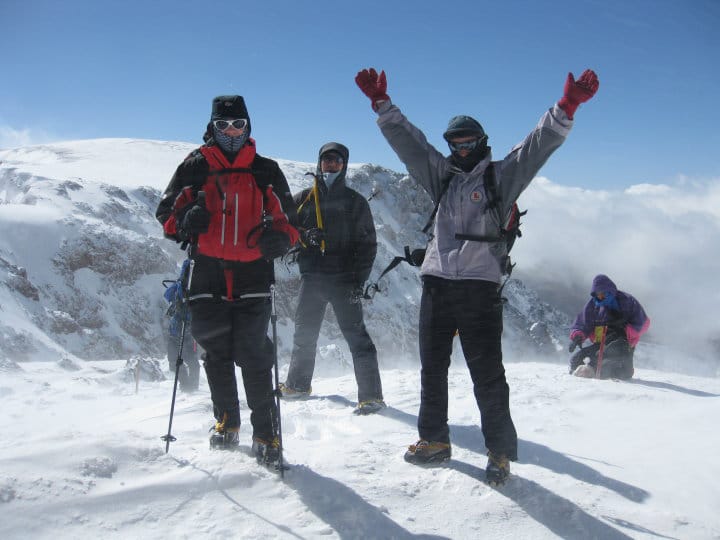
1). Acclimatization on Mount Toubkal
Climbing Mount Toubkal, North Africa’s highest peak at 13,671 feet (4,167m), is often marketed online as a quick two-day trek. However, this approach is risky and not recommended unless you already live at high altitude and are used to hiking for eight or more hours a day. For the best chance of success, proper acclimatization is essential. That’s why we only offer a seven-day Mount Toubkal itinerary, designed with optimal safety and enjoyment in mind.
By spending at least five days on the mountain, you give your body the necessary time to adjust to the thinner air, greatly reducing the risk of altitude sickness and increasing your summit success rate. Acclimatization isn’t just about performance—it’s about safety first. On any high-altitude adventure, including Toubkal, gradual adaptation to altitude should always be your top priority.
2). Physical Preparation for Climbing Mount Toubkal
Climbing Mount Toubkal requires more than just enthusiasm—it demands solid physical preparation. Trekkers should be ready to hike for 6 to 8 hours per day on consecutive days, often on rocky trails and steep mountain terrain. Training in advance on uneven ground, hills, and with a weighted backpack will best replicate the conditions you’ll face on Toubkal.
While our experienced guides set a safe and steady pace for both the ascent and descent, your own preparation is what makes the climb enjoyable rather than exhausting. Building endurance, leg strength, and balance before your trip will greatly increase your chances of reaching the summit of North Africa’s highest peak with confidence. Contact us for more information.
Recommended training activities include:
- Hill or stair climbing with a weighted backpack to simulate steep ascents in zone 2 heart rates.
- Long-distance hikes (5–7 hours) on uneven or rocky terrain, trying to get in over 2,300 feet (700m) in elevation.
- Strength training focused on legs, core, and back. This is needed for better endurance and strength.
- Yoga for recovery and flexibility.
- Back-to-back training days to mimic multi-day trekking fatigue.
With the right preparation, you’ll not only reach the summit but also enjoy the journey with confidence and energy.
3). Have the Correct Clothing
Weather in the Atlas Mountains can change quickly and dramatically, which means having the right clothing is essential for both comfort and safety. In winter, Mount Toubkal often experiences snow, ice, and freezing temperatures, requiring a proper layering system and specific mountaineering gear. In summer, conditions are warmer, but strong sun exposure, cool mornings, and the potential for sudden storms still demand versatile clothing choices.
We provide a detailed kit list in our trip dossier, but as a rule of thumb, think in layers so you can easily adapt to changing conditions throughout the day. At a minimum, you should bring:
A waterproof and windproof jacket for protection against rain, snow, or high winds.
Warm layers, such as a fleece or insulated jacket, for cold mornings and evenings.
Moisture-wicking base layers to keep sweat away from your skin.
Lightweight, breathable clothing for trekking in the sun.
Proper trekking boots and quality sleeping bag
A warm hat and gloves, even in summer, as temperatures can drop sharply at altitude.
Having the correct gear not only improves your chances of a successful climb but also ensures that you stay safe, comfortable, and able to fully enjoy the experience. If you are unsure about what to pack, contact us—we’re happy to advise based on the season you plan to climb.
4). Arrive Early in Marrakech
For the best experience on your Mount Toubkal trek, we strongly recommend arriving in Marrakech at least one day before your hike begins, especially if you are traveling from the US, Australia, UK or other distant locations. This extra day allows your body to begin acclimatizing to the new environment, recover from jet lag, and adjust to local time and climate.
It also gives you the chance to explore the vibrant streets, markets, and culture of Marrakech, making your trip richer and more enjoyable. Starting your trek well-rested, relaxed, and acclimated dramatically improves your performance on the mountain, helps prevent altitude fatigue, and ensures you can fully appreciate the stunning landscapes of the Atlas Mountains.

5). Stay Hydrated and Eat Well
Proper hydration and nutrition are essential for a successful Mount Toubkal climb, especially at high altitude. The thinner air and physical exertion increase your risk of dehydration and fatigue, so it’s important to drink water consistently throughout the day, even if you don’t feel thirsty.
Equally important is eating the right foods to maintain energy levels. Aim for a balanced diet with carbohydrates, proteins, and healthy fats, and include snacks like nuts, dried fruit, or energy bars during the hike. Our premium Toubkal treks provide hearty, freshly prepared meals each day, designed to refuel and energize you for challenging days on the mountain.
By staying well-hydrated and properly nourished, you’ll improve your endurance, reduce fatigue, and enjoy a safer and more rewarding trek to the summit of North Africa’s highest peak.
6). Use Trekking Poles
Trekking poles are an essential tool for ascending and descending Mount Toubkal, helping reduce strain on your knees and joints during both steep ascents and descents. They also provide extra stability on rocky, uneven, or slippery terrain, which is common on the Atlas Mountains trails.
For the best results, choose poles that are adjustable, lightweight, and durable, allowing you to customize the height for comfort and efficiency. Using trekking poles not only conserves energy but also improves balance and safety, especially during long days of hiking or on challenging summit approaches.
Our guides can provide tips on proper pole technique to maximize your performance and comfort throughout the trek, ensuring you enjoy a smoother and safer journey to the top of North Africa’s highest peak.
7). Choose the Right Footwear
Selecting the right trekking boots is crucial for a safe and enjoyable Mount Toubkal climb. The trails can be rocky, uneven, and steep, so boots with strong ankle support and a durable, grippy sole are essential for stability and comfort. Check out some tips for high altitude trekking.
Before your trek, break in your boots to prevent blisters, hotspots, or discomfort on long days of hiking. Pair your boots with moisture-wicking socks, ideally merino wool, to keep your feet dry, warm, and comfortable throughout the climb.
Proper footwear not only protects your feet but also improves balance, reduces fatigue, and allows you to focus on enjoying the stunning views and experience of the Atlas Mountains.

8). Pack Light but Smart
Packing the right items for your Mount Toubkal trek is essential for comfort, safety, and energy conservation. While it’s important to keep your backpack light, you also need to carry all essentials for long days on the mountain.
Your pack should include:
- Water and snacks for hydration and energy between meals.
- Extra layers to adjust to changing temperatures throughout the day.
- First aid kit and any personal medications and compeeds.
- Sun protection such as sun hoody, sunscreen, sunglasses, and a hat.
- Head torch for early starts or navigating in low light.
By packing smartly and efficiently, you’ll conserve energy, move more comfortably, and be prepared for unexpected weather changes. On our premium Toubkal climbs, our team also assists with gear checks and can advise on any additional daily essentials to ensure you are fully prepared for a safe and enjoyable trek.
9). Respect the Environment and Local Culture
Mount Toubkal lies within Toubkal National Park, a protected area with incredible biodiversity and fragile ecosystems. Following Leave No Trace principles—such as carrying out all waste, staying on marked trails, and respecting wildlife—is essential to preserve this natural beauty for future generations.
Equally important is showing respect for the Berber culture. As you pass through villages on the trek, take the time to appreciate local customs, traditions, and ways of life. Interacting respectfully with local communities not only enriches your experience but also supports sustainable tourism in the Atlas Mountains region.
Our premium Toubkal treks emphasize environmental responsibility and cultural awareness, ensuring that your adventure is not only safe and enjoyable but also ethically and environmentally conscious.
10). Trust Your Guides
Having experienced guides is one of the most important factors for a safe and successful Mount Toubkal climb. Our guides are experts in the Atlas Mountains, trained to monitor your condition, manage the pace, and provide valuable insights about the terrain, weather, and local culture.
Listening to your guides’ instructions is crucial for altitude safety, energy management, and overall enjoyment. They can advise when to rest, hydrate, or adjust your pace, ensuring that you reach the summit safely while maximizing your experience.
On our premium Toubkal treks, guides also provide personalized support, including tips on gear, nutrition, and acclimatization strategies, giving you confidence and peace of mind from start to finish. Trusting your guides allows you to focus on the adventure and fully enjoy the stunning landscapes of North Africa’s highest peak.
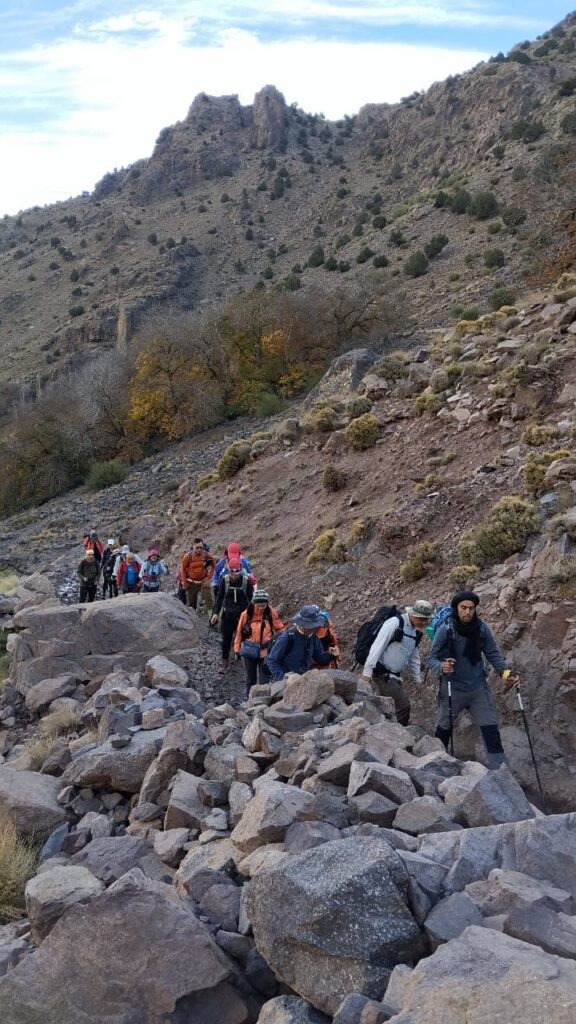
Top Tips for Climbing Mount Toubkal
Don’t be Disappointed
Mount Toubkal’s summit stands at 4,167m (13,671 feet) above sea level, Mount Toubkal – also known as Jebel Toubkal – is the highest mountain in Morocco, the Atlas Mountains, North Africa and the Arab World.
I have been to the mountain many times over the last 20 years and although you will read about people making speed ascent and two ascents. Trust me, you need more time, especially if you live at sea level and not an avid hiker.Check out our itinerary.
How Long Does it Take to Climb Mount Toubkal?
The Mount Toubkal ascent requires five days. There are some 6+ hours days of hiking to best be prepared for hiking on uneven terrain. We will follow a zigzagging path up into the rocky valley towards towering snow-dusted peaks on the horizon.
We spend three nights at the Refuge at 3,207m at the base of Toubkal where we’ll enjoy the best rooms and our base for our acclimatization hikes.
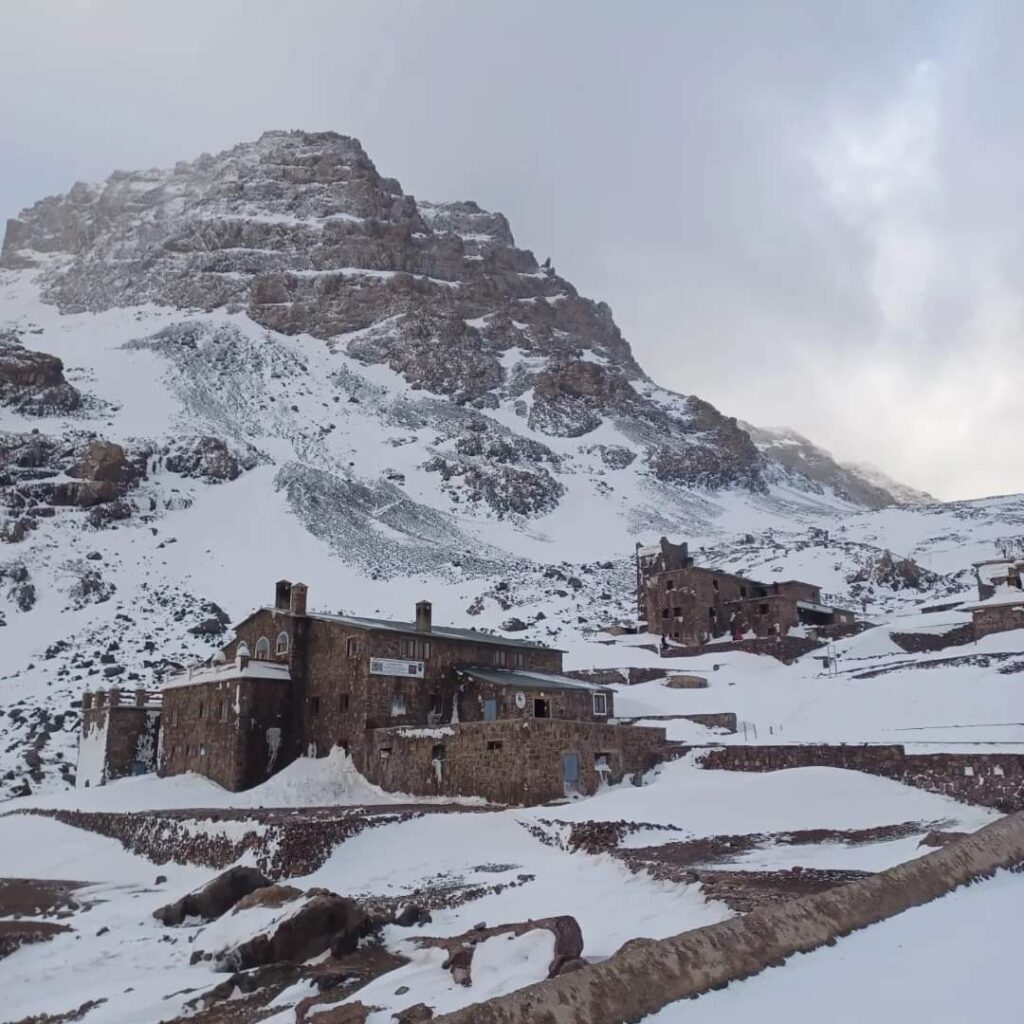
What is the Weather Like on Mount Toubkal?
Located in Morocco’s Atlas Mountain range, Mount Toubkal is often considered a hot trekking destination. However, while temperatures in Marrakech will range between 80°F and 100°F during the summer trekking season, the valleys of the High Atlas Mountains are typically cooler, especially the further up you walk.
The weather is mostly dry, with very little rainfall and clear blue skies, but clouds of mist can roll in over the mountains as you gain altitude. In winter the temperatures can drop to around 20°F at night, while in summer on our Toubkal Long Weekend they stay above 50°F on average.
If you fancy a more challenging Mount Toubkal trekking experience, book our Toubkal Climb tour in April, May or October, November when the temperatures are lower, and there’s a chance of some early/late snow on the summit. We also manage full winter ascents.
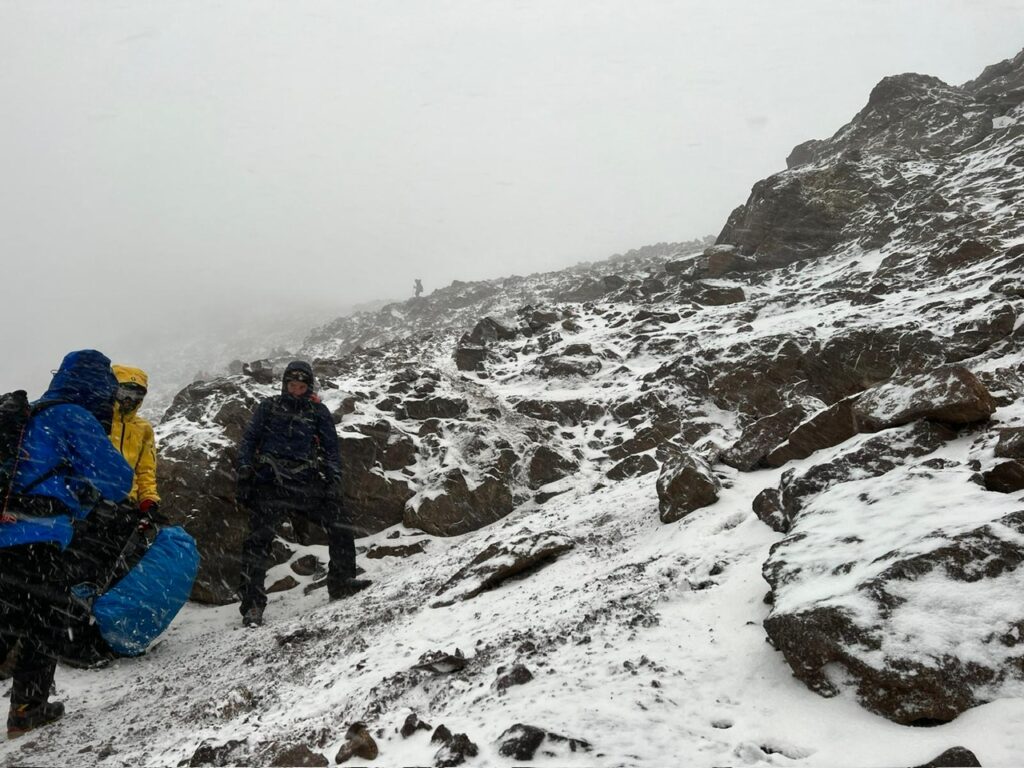
What is the Best Food for Climbing Mount Toubkal?
We have designed our menu to support the depends of a multi-day trekking adventure. It’s vital that you eat enough of the right food to get you up and down Mount Toubkal safely.
Every day, our hard-working trekking support team cooks up delicious freshly-prepared meals to replenish your energy reserves and refuel you for the next leg, including a very hearty breakfast on summit day.
Tuck into juicy fruit and crisp salads, as well as nuts and dates throughout the day, and if you want extra supplies, snacks are available to buy along the route. Last but not least, it’s crucial to keep well hydrated at all times to prevent dehydration.
Month-by-Month Guide to Trekking Mount Toubkal
January – Winter in the High Atlas
Temperature: 12°F to 27°F at higher elevations.
Conditions: Heavy snow cover, icy trails, crampons and ice axes essential.
Experience: Quiet trails but challenging winter mountaineering conditions. Best for experienced climbers with technical knowledge
February – Deep Winter
Temperature: 14°F to 42°F.
Conditions: Deep snow, avalanche risk in certain gullies, icy ridge lines.
Experience: Requires mountaineering skills. Stunning alpine scenery but not suitable for beginner trekkers.
March – Early Spring Snowpack
Temperature: 20°F to 46°F.
Conditions: Snow still lingers on trails, especially above 3,000m. Lower trails may start to clear.
Experience: Good for ski touring and winter ascents, but still technical. Weather can be unpredictable.
April – Transition Month
Temperature: 25°F to 50°F.
Conditions: Snow melting, mixed underfoot conditions (snow, slush, and exposed rock).
Experience: Less technical than winter, but some snow crossings still required. A great month for those wanting fewer crowds with manageable conditions.
May – Spring in Full Bloom
Temperature: 32°F to 64°F.
Conditions: Lower valleys are green with wildflowers, snow patches remain on higher slopes.
Experience: Excellent trekking month with mild conditions. Crampons may still be needed, but routes are largely accessible.
June – Start of Summer Season
Temperature: 35°F to 72°F.
Conditions: Most snow is gone, trails dry and stable.
Experience: Fantastic time to climb with good visibility and comfortable temperatures. Popular month for trekkers.
July – Warm Summer
Temperature: 50°F to 77°F.
Conditions: Clear trails, little to no snow. Warm during the day, cooler at night.
Experience: One of the easiest months for trekking. Busy with summer visitors. Start hikes early to avoid afternoon heat.
August – Peak Summer
Temperature: 53°F to 82°F.
Conditions: Dry, dusty trails, stable weather.
Experience: Busy trails, hot conditions in lower valleys. Higher altitude offers cooler air. Great for those looking for a non-technical, summer climb.
September – Ideal Conditions
Temperature: 46°F to 71°F.
Conditions: Clear skies, dry trails, and stable weather.
Experience: One of the best months for Toubkal. Fewer crowds than summer, great visibility, and comfortable trekking.
October – Autumn Colors
Temperature: 41°F to 64°F.
Conditions: Crisp mornings, clear skies, stable underfoot conditions. Some chance of early snow late in the month.
Experience: Excellent month to climb. Lower valleys glow with autumn colors, high trails still accessible.
November – Early Winter
Temperature: 28°F to 53°F.
Conditions: Increasing snow above 3,000m, icy mornings, mixed trails.
Experience: Good for adventurous trekkers, but winter gear needed toward the summit. Quieter season.
December – Full Winter Returns
Temperature: 14°C to 41°F.
Conditions: Heavy snow on upper slopes, icy conditions.
Experience: Requires crampons and winter gear. Beautiful but demanding. Only recommended for experienced winter climbers.
Best Months to Trek Mount Toubkal
Best Overall: May, June, September, October – Stable weather, comfortable temperatures, and excellent trekking conditions.
For Winter Mountaineers: January, February, March, December – Technical climbing, ice axes and crampons required.
For Fewer Crowds: April and November – Quieter trails, but mixed conditions.
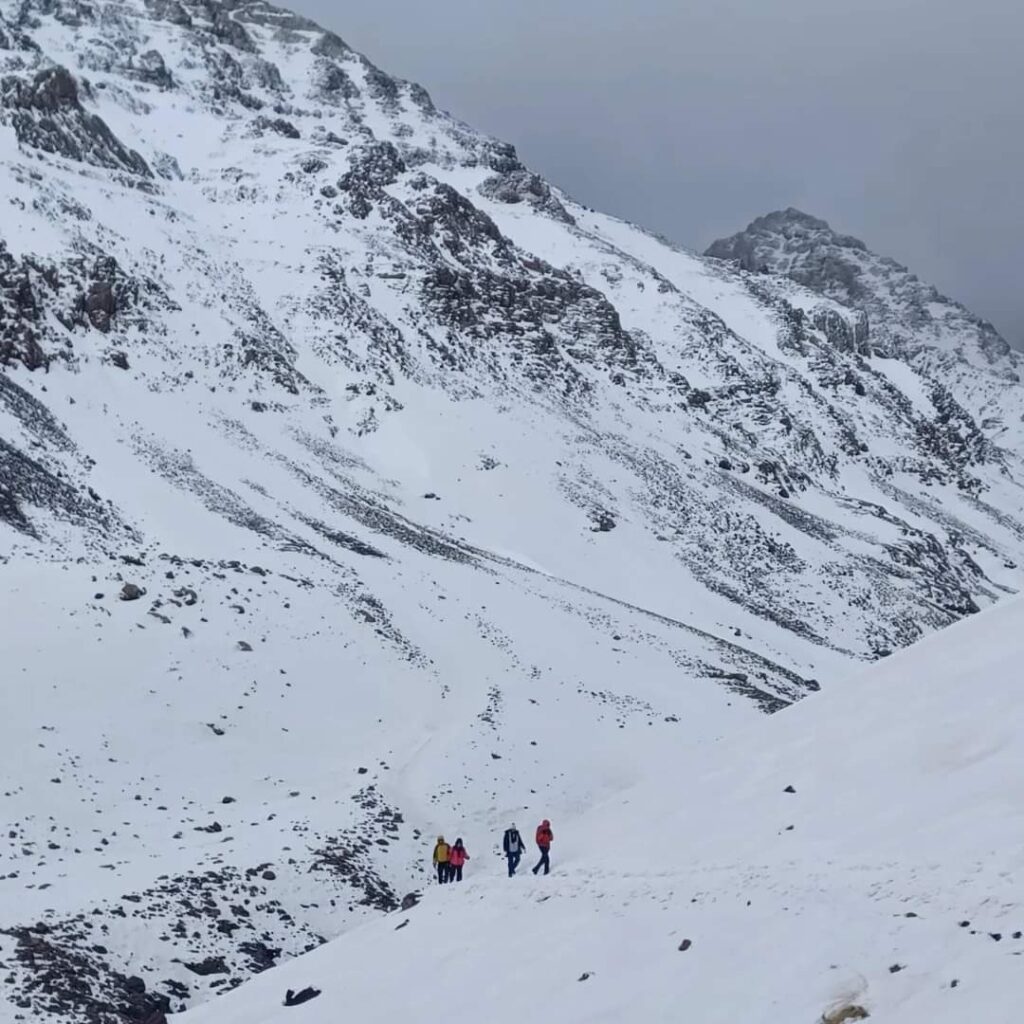
What Should I Pack to Trek up Mount Toubkal?
To make the most of your Mount Toubkal trek, make sure you’re well prepared. The weather can change in an instant up in the mountains so pack layers of moisture-wicking clothing that you can easily add or remove depending on the conditions.
Temperatures tend to drop dramatically at night, so a warm fleece, a good-quality down jacket and a wind and waterproof shell jacket are essential. We recommend bringing some breathable trekking pants and on summit day, you’ll also need a warm hat, buff waterproof/windproof gloves and a head torch for the pre-sunrise trek.
For your feet, we suggest trekking boots with ankle support paired with liner socks under a pair of merino wool full cushion trekking socks. Good-quality sunglasses (category 4) will protect your eyes from glare at high altitudes and make sure you use a high factor sunscreen. We will provide an itemized kit list on signing up.
A High-Quality Sleeping Bag
A high quality sleeping bag is an absolute must, whatever the time of year you visit Mount Toubkal. A 3-season sleeping bag (15F) is recommended June – August and a 4-season (0F) one in April, May, September, October and November.
Bring a refillable Camel bak hydration reservoir along with a Nalgene bottle. We won’t have electricity at some of the stopovers, so bring a power bank to charge your phone or camera, and you might want some extra batteries for your torch.
Finally, take a 30L backpack to carry everything you need during each leg of the hike. The rest of your kit will be carried up to the next camp by our mules.
Consider Nuun tablets or Luquid IV for optimal hydration. Consider some energy bars, protein bars and trail mix that can be used on the summit day.
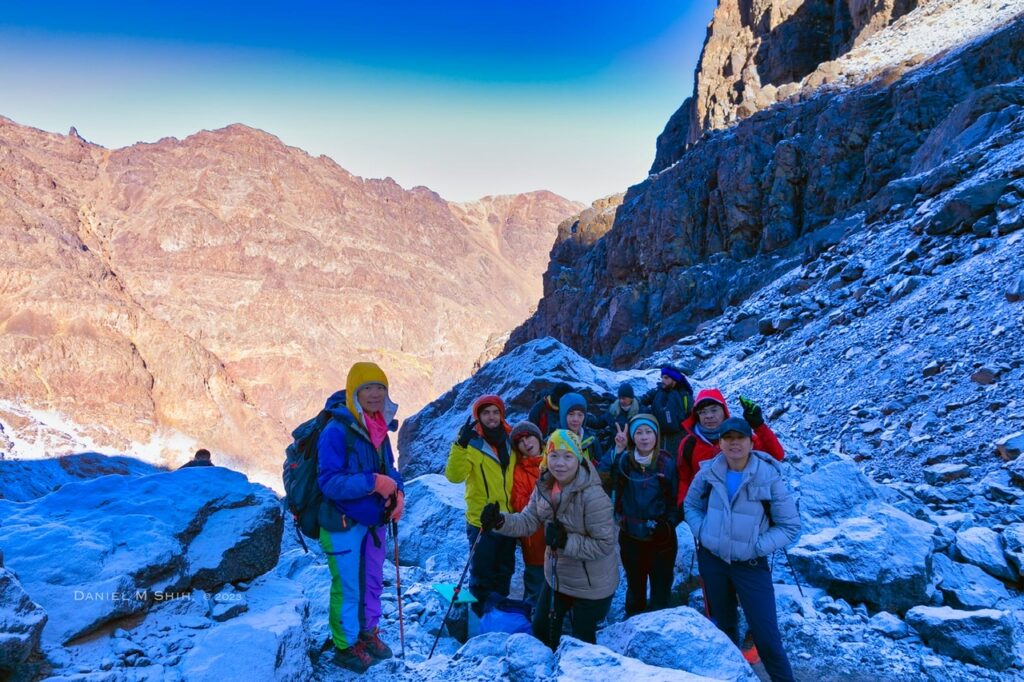
Treat Your Feet Well
Never underestimate having the correct trekking boots and the importance of good socks. We recommend have two pairs of merino wool socks and an additional pair for the summit night and one more for your change of clothing in camp.I prefer smartwool products.
It is worth having compeed blister pads with you. We will provide you with a full list of everything you need for the climb.
Break in your Trekking BootsI
If you are hiking on a regular basis this should not be a problem, but if you have been doing most of your training on a stair master. It’s a good idea to do some hiking in the boots you’re going to wear prior to climbing Toubkal.
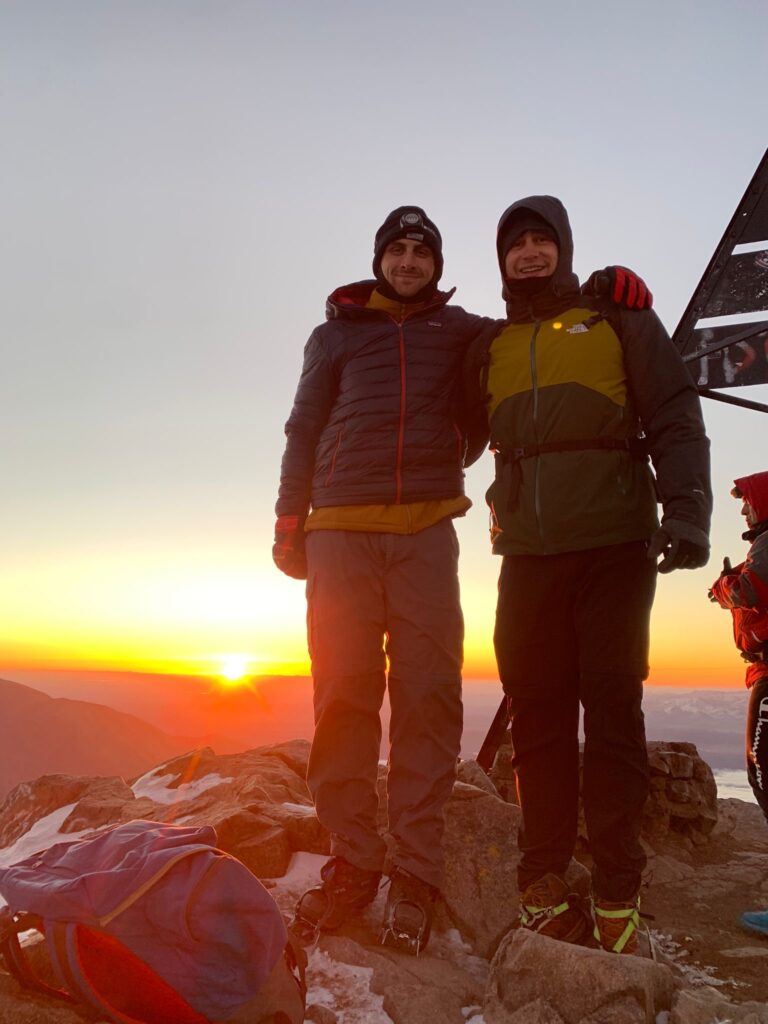
Mentally and Physical
Without the physical training it’s hard to apply the mental The hiking route, from the summit of Jebel Toubkal heading back to Imlil, where the hike starts. If you’re going to climb up and down it over the course of a weekend you’ll need to go at a fairly decent pace. On the first day of the climb, you’re walking 6.2 miles (10km) and racking up 1,540m of elevation. On the second day, it’s a full 10.5 miles (17km); 1,130m up, 2,530m down.
Needless to say, this isn’t your standard walk in the park. The days can be long, and you’ll have to call on your old friend ‘stamina’ in order to keep putting one foot in front of the other. Mentally speaking, the way down can be harder as you’ll feel like you’ve already achieved what you set out to achieve (and you’re going over old ground, albeit with a view in a new direction). Just remember to keep enjoying the incredible views, the brilliant company and the fact you’ve just summited a peak over 4,000m above sea level. Remember to smile.
Head Torch
Knowing exactly where your head torch is, and being able to access it easily, might sound like overly simplistic advice. But when you’re desperately scrabbling around for it in the darkness of the mountain refuge.
Refuge du Toubkal might be a step up on your standard Scottish hut in terms of amenities, but its size can also make it trickier to explore after dark.
The multi-storey refuge was built in 1938 and houses four dormitories. The biggest of these sleeps 27 in a relatively tight space (if you’re a light sleeper, you’ll be wanting to take some earplugs). Just over 80 people can stay here in total, making for a fun but crowded atmosphere in the dining area when it’s at capacity.
The refuge’s bathroom has two basic showers and three toilets, so you’re reasonably well catered for on that front – but the corridors are not, in my experience at my least, well-lit. Hence: head torch.
More importantly than helping you find your way to the toilet in the night, though, your head torch will come into its own when you leave the refuge well before daybreak in order to catch epic sunrise views up on the summit. Make sure you know where all your gear is and make sure you keep your head torch handy.
Respect the Altitude
Just because the Atlas Mountains are not the Himalayas, and Toubkal isn’t Mount Everest, doesn’t mean altitude sickness isn’t a thing. It is important to pick an itinerary with more acclimatization not less.
I see people with altitude sickness on Toubkal and it makes no sense. Are you coming on holiday to get sick? It is crazy to not have more days and nights sleeping at altitude to over a better experience. It is also a safety issue as you will not be as aware of your surroundings as you need to be.
Altitude Sickness Prevention
If you feel unwell on the mountain, tell one of our guides as they have a tool kit for high altitude. Even if you’re close to the summit, it’s always okay to stop or turn back.
What I would say to anyone thinking about taking on Toubkal. Take more time! and pick a longer itinerary. It is that it’s worth gaining some awareness of altitude sickness before signing up. Knowing the signs to look out for in yourself and others is sensible.
Listen to Our Guides
Our guides you’re with, of course, have a sharp sense for this kind of thing but you’ll make their job easier if you’re on the lookout too.
Even if you’re close to the summit, it’s always okay to stop or turn back. You should always carry Diamox and Ibuprofen is a must. Respect the mountain, respect how your body’s feeling and follow our pace for a safe and successful ascent and descent.
Drinking alcohol before or during a big climb should also be avoided, and can dehydrate you. Toubkal is a mountain at high altitude – so be smart.
Take Some Cash
It’s unlikely you’ll be doing much shopping on Toubkal. There are some lovely souvenir stalls on the trail; selling local handcrafted items. Contactless card payment opportunities are, unsurprisingly, rare so it makes sense to have some cash on you. If you are looking to buy something from one of these friendly vendors, we would – for obvious reasons – recommend doing so on the way down rather than the way up.
Tips The Team
I hope these Top Tips for Climbing Mount Toubkal were useful. Feel free to contact us today and learn more about our unique itinerary and service. We recommend USD $150 for a tip.
It is important to show some appreciation for your local mountain guides at the end of the trip. Not only have they helped get you and your gear up the mountain, they’ve also had to spend much of the last week supporting from from start to finish.
